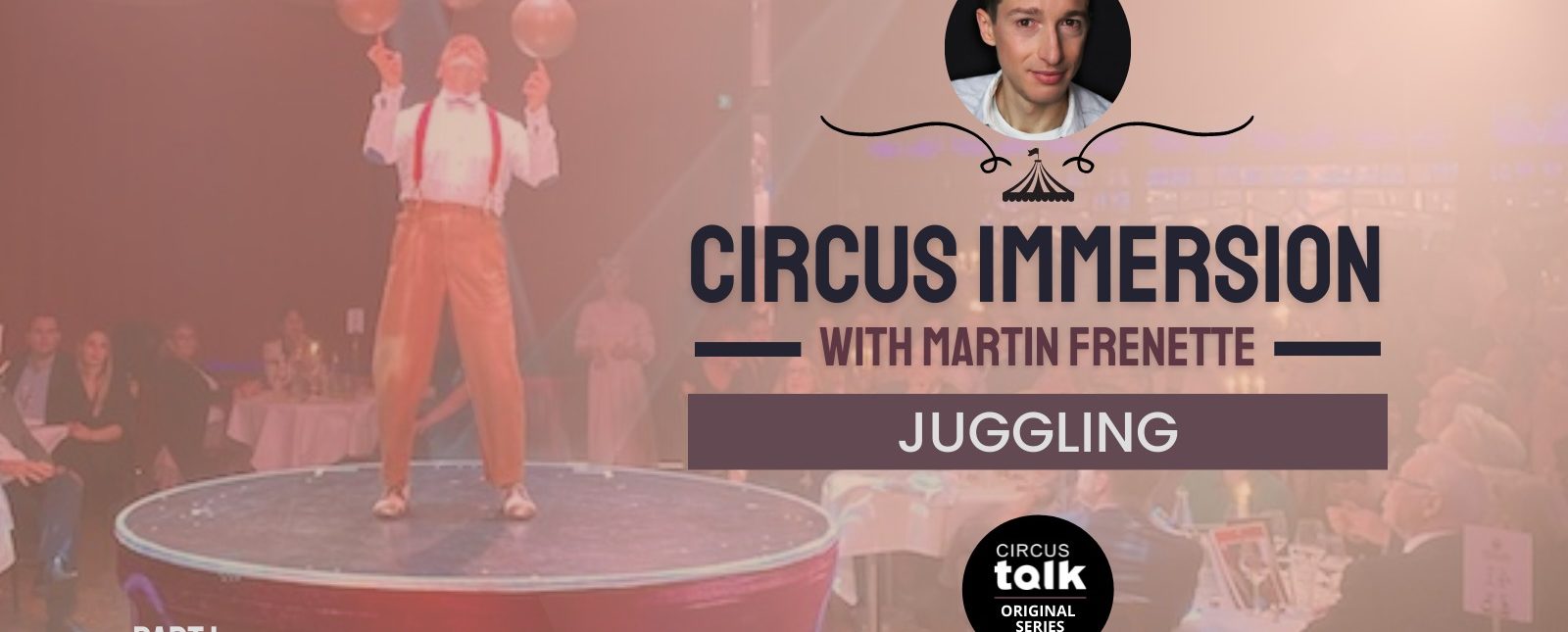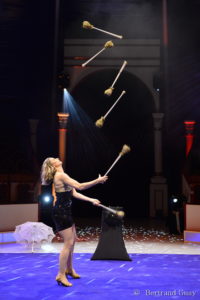Circus Immersion: It’s More Than Just Throwing Objects in the Air

In this short series titled Circus Immersion, Martin Frennette explores the ins and outs of a circus discipline through the eyes of its practitioners, starting with juggling.
Juggling. One word that evokes different images to each and every one. A Mexican man running in the center of the ring, tossing and catching spinning clubs as quickly as the orchestra’s high-speed music. A tall, slender, French man walking on stage, balancing a ball on the top of his head, and articulating his long limbs across the floor while manipulating the light sphere. Here comes the show’s femme fatale with her umbrella and foot juggling balls. They’re bouncing off her feet while she’s trying to seduce and connect with the audience with her lower body alone. One was born in the family’s circus, a chance encounter at a street’s juggling show geared the other away from dance studios and towards circus school. The last one, bored with acro sport, rediscovered her body and its abilities at Kyiv’s art academy. Three different styles, three very different paths, and yet one unifying point: juggling.

Some argue that one just has to keep on throwing objects in the air and that there is no secret recipe to become a juggler, others insist that there are different ways to define this discipline and make it one’s profession. For Victor Rubilar, juggling looked like magic when he was first introduced to it. Seeing Michael Moschen manipulating and making objects fly instantly fascinated the teenager who would eventually leave his native Argentina to train at Stockholm’s DOCH/SKH. “I saw this Spanish guy juggling footballs in the streets of Buenos Aires and it was a revelation. That was what I wanted to do. I went up to him, asked for a workshop, and spent three days training with him. I wrote everything down and learned as much as I could in three days as there were no online community nor videos back then. I stuck to those balls at circus school, came up with my own moves, and translated traditional juggling tricks to my footballs.”
It might all sound very academic and orderly, but jugglers have more freedom of movement than other circus artists in the end.
The fact that one never loses their contact with the audience by going upside down or high above the ground, as well as juggling’s dynamic and challenging nature, are some of the reasons why the 40-year old has been devoting himself entirely to this discipline. It also stands out movement-wise as it is all about tempo. Juggling’s clear way of moving and counting makes it almost possible to write paths and sets on music sheets. Certain tricks and objects have a rhythm that must be followed and never tampered with in such melodies.
“It might all sound very academic and orderly, but jugglers have more freedom of movement than other circus artists in the end. No prop nor installation glue them to one specific spot. The movement is freer and allows one to take all the space needed to better express themselves with close to no restriction,” says Rubilar.

Jimmy Gonzalez, a 2012 alumni of Montreal’s Ecole national de cirque, shares similar sentiments regarding deeper movement possibilities. Rolling, jumping, even reaching out for a ball can look and feel far more elaborate. The French-Spanish juggler also insists on the importance of coordination, of being able to do and focus on several things at once when one chooses to make this discipline the center of their life.
“Most jugglers tend to be hyperactive, very fast people in their daily life. It might have something to do with this quick stop-it-from-dropping reflex that we all develop! Coordination, concentration, patience, and determination are musts. A good juggler must also succeed at being in the moment and everywhere at the same time.”
Being everywhere at the same time perfectly describes how this juggler made his stage debuts. Years ago, a summer camp’s closing day felt like the perfect opportunity to put on a show for his friends and their parents. The 9-year old spent 30 minutes juggling balls and clubs, dancing, showing off diabolo tricks, and filling the entire stage.
19 years, two circus schools, and a gold medal at the Cirque de Demain festival later, Gonzalez describes juggling as a choreographic tool. More than just another circus discipline, it is a way to experiment with sensations and a strong tactile experience. “Juggling is pure sensory pleasure. Now more than ever, it is less about prowess and has taken a turn towards a volunteer technical sobriety. For me at least!”
The 28-year old admits to a strong will to change his approach and switch his focus. Feeling that he has spent most of his career focusing on technique, this artist now wants to enjoy everything that surrounds him in performance and connect with the audience on a deeper level. Therefore, his decision to move away from his solo path to work in a group, be a part of a dancers-and-jugglers’ collective is not so surprising. A year of research on the human body and a broad range of sensations made him rethink his practice and profession. Group-focused dances and movement patterns, such as those taught at David Zambrano’s Passing Through woskshops, have become his main line of creation and inspiration. The real challenge is no longer about the number of balls being thrown in the air, but reproducing dance patterns while juggling with his colleagues.
Looking at him or any other juggler tossing objects high above their heads, one has to wonder if they feel attracted by this infinite space or firmly fixed to the stage. Rubilar insists that one must be grounded, that it is where the technique is, and that juggling is about weight, much like dance on some levels. As for his younger peer, he feels equally invested and attracted by both the ground and the air.

Back in France, Françoise Rochais, only a year away from her 30th juggling anniversary, reveals a clear attraction to what’s high above, regardless of her feet being firmly grounded on the stage. “My awareness and body’s position are on the ground and are extremely important. You can’t ever forget about them. The better you’re placed, the better you juggle, even with your eyes and a smile towards the sky!”
Coming from one of the world’s top female jugglers, these words must be true. Regarding the lack of women in her profession, the short brunette recognizes that juggling has never been seen as having the same aesthetic or elegant appeal as aerial or balancing acts. It does not look very feminine to most and being both highly skilled and feminine at once can be hard for some in her own opinion.
“However, I find that juggling borrows from several art forms and techniques. A woman can take what she likes from another discipline and integrate it into her act to make it more personal and feminine. Juggling is definitely a form of artistic expression and not a sport. It requires discipline, rigor, as well as a complete physical and emotional investment. It ain’t that different from these ‘more feminine disciplines’ when you think about it!”
If many think of their props as simple objects, Rochais has developed a special bond with her batons. Despite having added other objects to her juggling sets with time, she has never been able to let go of her first partners from the moment she first held them as a young cheerleader.

“They’ve followed me everywhere and I feel very attached to them. I’ve already spent so much time with them. I’d rather lose my personal belongings than have my juggling suitcase stolen! Most of my props were designed especially for me and I’ve made many myself. They cannot be found in juggling shops. I’ve also spent a lot of time just playing with them, exploring ways and figures to give my act this feminine touch. I wanted to make the object talk to better express my personality. Such a process had to go through my props and could not only be about the movement.”
Having never attended circus schools, Rochais turned her bedroom, the family’s backyard, and even her kinesiologist’s high-ceilinged office into her training spaces. The ever-growing online community, as well as the numerous conventions, have been allowing many to develop their skills and come up with an act without attending a professional circus school. The former child cheerleader trained by herself, however, as conventions and juggling associations were not a thing in the ’80s.
“We didn’t even have juggling shops! I did it all on my own with one initial goal in mind: taking part in the Cirque de Demain Festival. I was the exact same age as Anthony Gatto when I saw him perform there. I had to give it a shot! Having clear goals really helps to stay disciplined and rigorous as a juggler. Five years later, I was juggling on the Festival’s stage.”
The 46-year old doesn’t like drops, but thinks that they can make the audience more aware of an act’s technical difficulty, Much like her Argentinean and French colleagues, she usually plays with the audience and uses the energy of the moment to build momentum. Gonzalez has learned to accept them and advises artists to not only focus on details but to see their performance as a whole. One that can include a drop. Rubilar sees it as an opportunity to play and connect with the audience. “It really isn’t that bad if it happens as you can really get them on your side and earn some extra energy as they cheer for you.”
In spite of coming from three very different backgrounds and leading careers with little in common, their views on juggling’s next chapter sound similar: The batons spinner envisions a far more artistic future where comedy and characters can shine more than tricks and throws. The football master first acknowledges the important impact Youtube had on the discipline, turning impossible tricks into a thing of the past with online exchange and tutorials. He’d, therefore, like to see this knowledge sharing expand with more jugglers learning from and with each other. The integration of technology, in the form of light, sound, or special effects, is something that many have dabbled in and that could lead to much more for both the community and their audience in his own words.
As for the group dance enthusiast, he thinks juggling will really evolve and move forward if it is less technique-driven and allows minimalism to get more recognition.“Jugglers need more room to play, just play with objects. That sense of amusement could be more present if sensitivity and technical sobriety were more welcome on stage.”
Finally, when asked if and how juggling is better than other disciplines, all three jugglers burst out laughing… before stating that it obviously is the best!
“I would not necessarily recommend it to everyone, but it isn’t as rough on one’s body as other circus disciplines. No one has ever died in the middle of an 8-ball sequence! I’m personally fond of this great balance that can be found between technique and artistic. I’m a little worried about the new generation though. They seem to be craving quick results, lacking the motivation and will to persevere and be as rigorous as those who came before them,” are Rochais’ parting words.
“Let’s be real, juggling is the best! Like superheroes, each discipline has superpowers. Juggling’s would be allowing artists to stay in touch with the audience while being very skillful. Some acts are just visually interesting, juggling can be beautiful while being very technical end equally entertaining” adds Rubilar.

As for Gozalez, he wraps up by comparing juggling to skateboard in the way that it can almost be practiced anywhere and that they both have a real worldwide community. Without over-looking circus’, he points out that juggling really has its own energy and particularities that are foreign to other disciplines. The 28-years old likes this special bond and how jugglers can connect and run into each other on stage as much as on the street… Just like skateboarders!
All photos provided courtesy of Martin Frenette. Feature photo Victor Rubillar performing at Dinner For Fun
Editor's Note: At StageLync, an international platform for the performing arts, we celebrate the diversity of our writers' backgrounds. We recognize and support their choice to use either American or British English in their articles, respecting their individual preferences and origins. This policy allows us to embrace a wide range of linguistic expressions, enriching our content and reflecting the global nature of our community.
🎧 Join us on the StageLync Podcast for inspiring stories from the world of performing arts! Tune in to hear from the creative minds who bring magic to life, both onstage and behind the scenes. 🎙️ 👉 Listen now!
